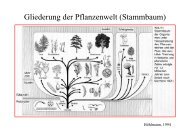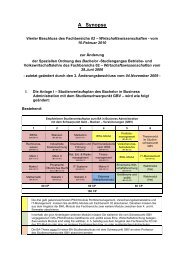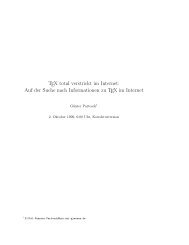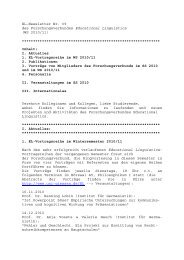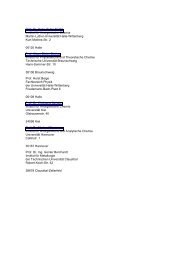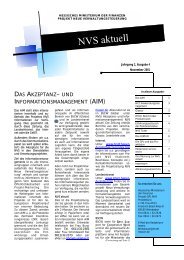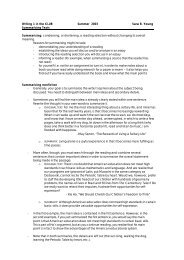Elizabeth- the Virgin Queen
Elizabeth- the Virgin Queen
Elizabeth- the Virgin Queen
Create successful ePaper yourself
Turn your PDF publications into a flip-book with our unique Google optimized e-Paper software.
<strong>Elizabeth</strong>- <strong>the</strong> <strong>Virgin</strong> <strong>Queen</strong>
Birth of a queen<br />
• was born on <strong>the</strong> 7th of September in 1533 at Greenwich<br />
Palace<br />
• fa<strong>the</strong>r: Henry VIII of England<br />
• mo<strong>the</strong>r: Ann Boleyn<br />
• her birth was worst disappointment for her fa<strong>the</strong>r<br />
King had made big efforts to get rid of his first wife Ca<strong>the</strong>rine of<br />
Aragon to marry Ann<br />
never<strong>the</strong>less, <strong>Elizabeth</strong> was given a magnificient christening<br />
on <strong>the</strong> 10th of September
The royal bastard<br />
• Ann Boleyn became unpopular and a problem for Henry<br />
accused her of adultery and executed her on <strong>the</strong> 19th of May<br />
1536<br />
As a consequence, <strong>the</strong> marriage between Henry and Ann<br />
Boleyn was annulled and <strong>Elizabeth</strong> was made illegitimate by<br />
Parliament<br />
- <strong>Elizabeth</strong> enjoyed an excellent education<br />
- had a special skill for languages<br />
- also interested in arts, music, reading and writing<br />
- taught by <strong>the</strong> famous scholars William Grindal and Roger<br />
Asham<br />
- extraordinary talented student<br />
- learned <strong>the</strong> art of public speaking<br />
was very helpful later on
Family and friends<br />
• <strong>the</strong> rapid change of <strong>the</strong> wifes of her fa<strong>the</strong>r must have had a<br />
tremendous influence on young <strong>Elizabeth</strong><br />
• her governess Ka<strong>the</strong>rine Champernowne, called „Kat“, was a<br />
mo<strong>the</strong>rly figure, she later married <strong>Elizabeth</strong>´s cousin John<br />
Ashley<br />
stayed very close friends<br />
- Robert Dudley was loyal to her since <strong>the</strong>ir earliest childhood<br />
- legends say, that when she was eight, she told him that she<br />
would never marry<br />
was probably afraid of <strong>the</strong> destiny that some of her step-<br />
mo<strong>the</strong>rs faced after marriage
<strong>Elizabeth</strong>´s childhood<br />
• on <strong>the</strong> 12th of October 1527 <strong>Elizabeth</strong>´s bro<strong>the</strong>r Edward was<br />
born<br />
• son of Jane Seymour and Henry VIII, Jane died after <strong>the</strong> birth<br />
• Edward and <strong>Elizabeth</strong> had a close relation right from <strong>the</strong> start,<br />
both had lost <strong>the</strong>ir mo<strong>the</strong>rs, both were Protestants and very<br />
smart students<br />
• <strong>Elizabeth</strong> and her older sister Mary were never that close<br />
• <strong>Elizabeth</strong> lived a ra<strong>the</strong>r quiet and hidden life until her fa<strong>the</strong>r<br />
died in January 1547<br />
she became vulnerable for those who saw her as a political<br />
threat, because Henry had reinstated his children in <strong>the</strong> line of<br />
succession in his last will<br />
Edward > Mary > <strong>Elizabeth</strong>
Political plots 1.<br />
• Edward was now to follow his fa<strong>the</strong>r on <strong>the</strong> throne<br />
• was only nine years old > his uncle Edward Seymour became<br />
Protector of England<br />
• His bro<strong>the</strong>r Thomas was jealous of him > wanted to kidnap <strong>the</strong><br />
„ boy king“ and marry <strong>Elizabeth</strong><br />
• <strong>Elizabeth</strong> was suspected to be involved in this plans, but was<br />
able to defend her innocence<br />
• but rumours occurred about an affair between Thomas and <strong>the</strong><br />
fourteen -year old <strong>Elizabeth</strong>, her reputation suffered<br />
• Thomas was sentenced to death
Political plots 2.<br />
• Edward Seymour was replaced by John Dudley, Earl of<br />
Warwick<br />
> fa<strong>the</strong>r of Robert Dudley, <strong>Elizabeth</strong>´s childhood friend<br />
John became Duke of Northumberland<br />
- in 1553 <strong>the</strong> „ boy king“ Edward became ill, was not going to<br />
survive<br />
preparations for <strong>the</strong> succession had to be made > heir was<br />
older sister Mary<br />
- Dudley wanted to preserve Protestantism and his own power<br />
solution: make Lady Jane Grey <strong>Queen</strong> of England<br />
was his daughter- in- law and also a descendent of Mary,<br />
Henry VIII sister
The question of succession<br />
• Edward died on <strong>the</strong> 6th of July 1553<br />
• Lady Jane Grey was proclaimed <strong>Queen</strong> of England<br />
but <strong>Elizabeth</strong>´s older sister Mary fought for her right to become<br />
<strong>Queen</strong>, she had <strong>the</strong> support of <strong>the</strong> English Nation<br />
on <strong>the</strong> 19th of July Mary was proclaimed <strong>Queen</strong> in London<br />
on <strong>the</strong> 24th John Dudley was arrested and executed<br />
- Mary now wanted to restore <strong>the</strong> Catholicism and negotiated to<br />
marry Prince Philip of Spain<br />
marriage was unpopular, fear of being dominated by Spain<br />
grew
Political plots 3.<br />
• Thomas Wyatt, a gentlemen from Kent raised a rebellion<br />
against Mary<br />
plan was to marry <strong>Elizabeth</strong> to Edward Courtenay, Earl of<br />
Devon , to ensure a native- born succession<br />
not known if <strong>Elizabeth</strong> was involved in it > denied it<br />
was send to Tower on <strong>the</strong> 18th of March 1554<br />
her popularity helped her to be soon released<br />
was <strong>the</strong>n send to <strong>the</strong> manor of Woodstock as a prisoner for<br />
about a year, guarded by Sir Henry Bedingfield´s men
<strong>Queen</strong> Mary<br />
• she was very unpopular > rumour of pregnancy proved<br />
untrue , burnt Protestants, involved England in a war with<br />
France > lost Calais<br />
• Mary´s husband Philip wanted <strong>Elizabeth</strong> to follow her sister on<br />
<strong>the</strong> throne<br />
reasons : Mary <strong>Queen</strong> of Scots was <strong>the</strong> next in <strong>the</strong> line of<br />
succession > was <strong>the</strong> granddaughter of Henry VIII sister<br />
Margaret and married to French heir<br />
Spain and France were enemies, so <strong>Elizabeth</strong> was <strong>the</strong> smaller<br />
problem<br />
Mary finally agreed before she died on <strong>the</strong> 17th of November<br />
1558
<strong>Queen</strong> <strong>Elizabeth</strong><br />
• <strong>Elizabeth</strong> received <strong>the</strong> news at her childhood home Hatfield<br />
House<br />
• was crowned on <strong>the</strong> 15th of January 1559 > people were<br />
thrilled<br />
• made religion her priority, re-established <strong>the</strong> Protestant faith in<br />
England, became Supreme Governor of <strong>the</strong> Church of<br />
England<br />
• was a pious person liked crucifixes and church music
<strong>Elizabeth</strong> and <strong>the</strong> men<br />
• now that she was <strong>Queen</strong>, marriage proposals floated in<br />
she refused <strong>the</strong>m all<br />
contenders were e.g.:<br />
Robert Dudley, Earl of Leicester sine 1564<br />
Francis, Duke of Anjou, heir to <strong>the</strong> French throne<br />
- <strong>the</strong> welfare of her country was more important to her than<br />
marriage<br />
- ministers saw it as a big problem, because of <strong>the</strong> succession<br />
<strong>Elizabeth</strong> wanted <strong>the</strong>se talks to be suppressed<br />
- never<strong>the</strong>less, she knew how to use flirtation for her matters<br />
surrounded herself with loyal people to be protected from plots
<strong>Elizabeth</strong> and <strong>the</strong> men<br />
• Robert Dudley Francis of Anjou
Political plots 4.<br />
• Catholics wanted Mary <strong>Queen</strong> of Scots on <strong>the</strong> throne<br />
• she was forced to flee her country and came to England<br />
looking for help from <strong>Elizabeth</strong><br />
was immediately imprisoned (more from Patrick)<br />
relationship to Philip of Spain also became worse, which led to<br />
a Spanish invasion ( more from Nina)<br />
- spent <strong>the</strong> 1590’s mainly by finding a way to govern Ireland<br />
this led to nine years war in 1594<br />
Earl of Essex was send, created only more problems<br />
her trusted ministers Walsingham and Burghley passed away<br />
Robert Dudley died in 1588
The final years<br />
• <strong>Elizabeth</strong> had been very popular right from <strong>the</strong> beginning<br />
had established a special relation to her people, for which she<br />
was loved<br />
her reign is still seen as <strong>the</strong> „ Golden Age“<br />
had created a prosper England, major player in Europe,<br />
established Protestantism and a stable government, had<br />
passed Poor laws<br />
she died on <strong>the</strong> 24th of March in 1603<br />
was followed by King James VI of Scotland
<strong>Elizabeth</strong>´s government<br />
• England was very structured in <strong>Elizabeth</strong>an times<br />
• government consisted of :<br />
• Monarch – Privy Council – Parliament<br />
• Monarch:<br />
<strong>Elizabeth</strong> was <strong>the</strong> ruler of <strong>the</strong> country, had to act in<br />
accordance with <strong>the</strong> law, decide when Parliament was going<br />
to sit, decide about religion, welfare, war, education etc.<br />
had <strong>the</strong> help of powerful men around her, was also supported<br />
by <strong>the</strong> o<strong>the</strong>r governmental institutions
Parliament<br />
• consisted like today of <strong>the</strong> „ House of Lords“ ( Upper House)<br />
and <strong>the</strong> „ House of <strong>the</strong> Commons“ ( Lower House)<br />
in <strong>the</strong> Lords sat <strong>the</strong> bishops and aristocrats<br />
in Common House sat common people, were elected by male,<br />
wealthy people<br />
main function was to pass laws and grant money to <strong>the</strong> <strong>Queen</strong><br />
- <strong>Elizabeth</strong> could also pass laws without <strong>the</strong> Parliament<br />
Royal proclamations<br />
<strong>Elizabeth</strong> summoned her Parliament mainly because of <strong>the</strong><br />
money
Privy Council 1.<br />
• main function: general administration of <strong>the</strong> country, matters of<br />
religion,military, queens security, economics, welfare of <strong>the</strong><br />
people, give advice to <strong>the</strong> <strong>Queen</strong><br />
• <strong>Queen</strong> determined who was in<br />
• work was delegated to secretaries<br />
• William Cecil was leader of <strong>the</strong> council and secretary of <strong>the</strong><br />
state, was effectively <strong>Elizabeth</strong>´s personal secretary<br />
He was known for great administrative ability, wise and<br />
cautious, queens chief advisor
Privy Council 2.<br />
• Sir Francis Walsingham was Cecil´s successor<br />
he started as his servant in 1568<br />
established a great spy network in England, defended<br />
<strong>Elizabeth</strong> against foreign powers<br />
in 1570 he was nominated ambassador of France<br />
in 1573 he was recalled and made secretary<br />
<strong>the</strong> privy council was supported by national, regional,<br />
county and community bodies<br />
royal representative in every county to ensure that laws are<br />
obeyed<br />
nobility and gentry were also powerful > owning land meant<br />
power
The Spanish Armada<br />
- King Philip II of Spain built 130 warships<br />
and organized 30,000 qualified soldiers to invade<br />
England.<br />
- This massive fleet of ships is called<br />
The Spanish Armada
Why did England and Spain<br />
go to war?<br />
- <strong>Elizabeth</strong>‘s rejection to Philip’s marriage proposal<br />
- Religious differences<br />
- Execution of Mary <strong>Queen</strong> of Scots<br />
- English sailors robbing Spanish treasure ships<br />
- Spanish aided plots<br />
- French Civil War<br />
- Dutch Revolt<br />
- <strong>Elizabeth</strong> and <strong>the</strong> Ne<strong>the</strong>rlands
The Defeat of <strong>the</strong> Spanish<br />
Armada<br />
- 1586 preparation for <strong>the</strong> Armada began<br />
- start was delayed because of <strong>the</strong> attack by Sir Francis Drake<br />
- May 9th, 1588 <strong>the</strong> Armada left <strong>the</strong> cost of Portugal<br />
- commanded by <strong>the</strong> Duke of Medina Sidonia<br />
- 130 ships and 30,000 men<br />
- anchored in Calais to wait for <strong>the</strong> forces of <strong>the</strong> Duke of Parma<br />
- English set some of <strong>the</strong>ir own boats on fire<br />
and sailed <strong>the</strong>m over to <strong>the</strong> Armada
The Defeat of <strong>the</strong> Spanish<br />
Armada<br />
- to get away from <strong>the</strong> burning ships <strong>the</strong>y drove back in <strong>the</strong> English<br />
Channel.<br />
- fights started<br />
- wind blew <strong>the</strong>m northward<br />
- <strong>the</strong>y were forced to sail around <strong>the</strong> tip of<br />
Scotland<br />
- bad storms wrecked many ships<br />
- only 69 ships returned
The Defeat of <strong>the</strong> Spanish<br />
Armada<br />
- <strong>the</strong> mighty Spanish fleet was defeated<br />
- <strong>the</strong> morale and international prestige of <strong>Elizabeth</strong>'s England raised<br />
- English believed: it was no ordinary storm but <strong>the</strong> work of God<br />
- "God blew and <strong>the</strong>y were scattered"
Cultural Developments<br />
- upper class: expected musical literacy<br />
- labors: sang while working<br />
- towns people: sang or played music after meals<br />
- favored instruments: lute, viola, recorder, bagpipe, fiddle<br />
- popular entertainment in <strong>the</strong> countryside: ringing church bells<br />
- Waits<br />
Music
Cultural Developments<br />
- very popular activity<br />
- mostly performed by couples<br />
Dancing<br />
- dancing varied according to social class<br />
- courtly dances: high social class<br />
- country dances: ordinary people<br />
- performances and ritual dances, most famous was Morris<br />
dancing
Cultural Developments<br />
- technical works, political and religious tracts, ballads, almanacs,<br />
and histories.<br />
- reading was affordable for everyone<br />
- public readings<br />
Literature
Cultural Developments<br />
- 1567 first <strong>the</strong>ater came to London<br />
- three-story galleries<br />
Theater<br />
- people from every social class attended<br />
- performances were held in <strong>the</strong> afternoon<br />
- most popular playwrights: Christopher Marlowe and William<br />
Shakespeare<br />
- women attended plays, but didn’t perform in plays
Cultural Developments<br />
- every season a celebration<br />
- Mayday celebration<br />
- Midsummer’s Eve on June 24 th<br />
- harvest festivals<br />
Feasts and festivals<br />
- Christmas until <strong>the</strong> 5 th of Jan.
Cultural Developments<br />
Sports<br />
- sports were regulated by government<br />
- high ranked people were expected to do sports to be trained for<br />
war<br />
- on Sundays <strong>the</strong> working class practiced archery<br />
- war games were very popular, for example:<br />
- hunting<br />
- jousting-preparation is quintain<br />
- hawking<br />
- hurling, forerunner of rugby
Cultural Developments<br />
Architecture<br />
- <strong>Elizabeth</strong>an architecture ranged from <strong>the</strong> 1500s-1600s<br />
- most significant: traditional building of churches stopped,<br />
building of houses began<br />
- use of classical symmetry( E and H style)<br />
- walls and fireplaces were onated<br />
- more windows<br />
- Harwick Hall in Derbyshire<br />
“ more glass than wall”
King Philip II
Sir Francis Drake
The Duke of Parma
quintainag3
Mary, <strong>Queen</strong> of Scots<br />
Mary Stewart (reign:<br />
1542 – 1567)
Mary, <strong>Queen</strong> of Scots<br />
• Mary Stewart was born on<br />
December 8 th , 1542 at Linlithgow<br />
Palace, West Lothian<br />
• Daughter of James V of Scotland<br />
and Mary de Guise<br />
• She was announced queen of<br />
Scotland only 6 days old, because<br />
her fa<strong>the</strong>r died<br />
• Scottish noblemen wanted to make<br />
peace with England and decided that<br />
Mary should marry <strong>the</strong> future Edward<br />
VI, son of Henry VIII
Mary, <strong>Queen</strong> of Scots<br />
• Mary‘s mo<strong>the</strong>r was chosen as regent<br />
• She opposed to <strong>the</strong> plan of <strong>the</strong> Scottish nobility,<br />
and wanted to streng<strong>the</strong>n <strong>the</strong> relationship with<br />
France<br />
• Mary was sent to France in 1548 to live with <strong>the</strong><br />
French royal family<br />
• She was also betro<strong>the</strong>d to <strong>the</strong> future king of<br />
France, <strong>the</strong> Dauphin Francis<br />
• Stewart Stuart ?<br />
• Henry VIII was furious about that and a number<br />
of attacks on scottish ground began, known as<br />
`The Rough Wooing‘
Mary, <strong>Queen</strong> of Scots<br />
• On April 24 th , 1558 Mary and <strong>the</strong> Dauphin<br />
Francis married in Paris<br />
• One year later he succeeded to his<br />
fa<strong>the</strong>r‘s throne as Francois II so Mary was<br />
now queen of Scotland and of France<br />
• In 1560 Francois II died of an ear infection<br />
• In 1561 <strong>the</strong> catholic Mary returned to<br />
Scotland, now an officially Protestant<br />
country
Mary, <strong>Queen</strong> of Scots<br />
• She ruled successfully and with<br />
moderation<br />
• In 1565 she married Henry, Lord Darnley,<br />
her second cousin, who was also catholic<br />
• Darnley became tool of Mary‘s enemies<br />
• He and some o<strong>the</strong>r conspirators killed her<br />
Italian secretary David Rizzio (who was<br />
said to be her lover and a papal agent) in<br />
front of her when she was 6-month<br />
pregnant<br />
• In summer 1566 Mary‘s and Darnley‘s son<br />
James was born
Mary, <strong>Queen</strong> of Scots<br />
• Darnley was murdered in Kirk o‘Field while<br />
Mary was on a party in 1567<br />
• People suspected her to be implicated in<br />
that crime toge<strong>the</strong>r with <strong>the</strong> Earl of<br />
Bothwell who was believed to be <strong>the</strong><br />
principal murderer of Darnley<br />
• 3 months later Mary and Bothwell married,<br />
he was <strong>the</strong>refore divorced from his wife!<br />
• Scottish nobility could not stand that and<br />
she was forced to abdicate her throne in<br />
favour of her son James
Mary, <strong>Queen</strong> of Scots<br />
• Her attempt to regain her throne ended with her getting<br />
captured and imprisoned at Lochleven Castle
Mary, <strong>Queen</strong> of Scots<br />
• She could escape and fled to England,<br />
hoping her cousin <strong>Elizabeth</strong> I would help her<br />
• Mary was imprisoned for 19 years until her<br />
execution at Fo<strong>the</strong>ringhay Castle in<br />
Northamptonshire on February 8 th , 1587<br />
aged 44<br />
• She was wearing red as a sign of dying for<br />
her faith<br />
• She was first buried in Peterborough<br />
Ca<strong>the</strong>dral, but her son James VI of Scotland<br />
and also I of England exhumed her in 1612<br />
and placed her body in Westminster Abbey
Mary Stewart vs. <strong>Elizabeth</strong> I<br />
• Why should <strong>Elizabeth</strong> I want Mary to be executed?<br />
Vs.
Mary Stewart vs. <strong>Elizabeth</strong> I<br />
• Although <strong>Elizabeth</strong> wanted to severe ties<br />
with Rome, she needed <strong>the</strong> common<br />
people and <strong>the</strong> majority of <strong>the</strong>m was<br />
Anti-Rome<br />
• Mary and <strong>Elizabeth</strong> were cousins. If<br />
<strong>Elizabeth</strong> had no children, Mary had a<br />
good claim on <strong>the</strong> English throne and<br />
England would become Catholic again<br />
• Catholics considered <strong>Elizabeth</strong> being<br />
illegitimate, because her mo<strong>the</strong>r, Ann<br />
Boleyn was married to Henry VIII illegally<br />
• Catholics plotted against <strong>Elizabeth</strong>
Mary Stewart vs. <strong>Elizabeth</strong> I<br />
• A long series of Catholic plots against <strong>Elizabeth</strong><br />
in order to assassinate <strong>the</strong> English queen made<br />
her ministers state: `so long as <strong>the</strong>re is life in<br />
her, <strong>the</strong>re is hope; so as <strong>the</strong>y live in hope, we<br />
live in fear‘<br />
• Mary was executed<br />
• `In my end is my beginning‘
Mary Stewart vs. <strong>Elizabeth</strong> I




